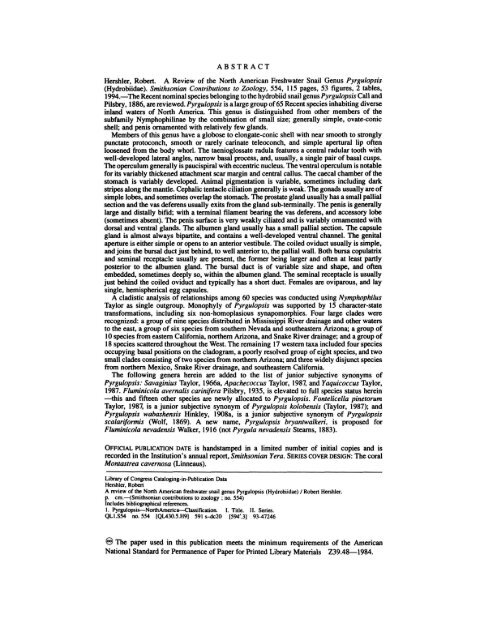A Review of the North American Freshwater Snail Genus Pyrgulopsis
A Review of the North American Freshwater Snail Genus Pyrgulopsis
A Review of the North American Freshwater Snail Genus Pyrgulopsis
You also want an ePaper? Increase the reach of your titles
YUMPU automatically turns print PDFs into web optimized ePapers that Google loves.
ABSTRACT<br />
Hershler, Robert. A <strong>Review</strong> <strong>of</strong> <strong>the</strong> <strong>North</strong> <strong>American</strong> <strong>Freshwater</strong> <strong>Snail</strong> <strong>Genus</strong> <strong>Pyrgulopsis</strong><br />
(Hydrobiidae). Smithsonian Contributions to Zoology, 554, 115 pages, 53 figures, 2 tables,<br />
1994.—The Recent nominal species belonging to <strong>the</strong> hydrobiid snail genus <strong>Pyrgulopsis</strong> Call and<br />
Pilsbry, 1886, are reviewed. <strong>Pyrgulopsis</strong> is a large group <strong>of</strong> 65 Recent species inhabiting diverse<br />
inland waters <strong>of</strong> <strong>North</strong> America. This genus is distinguished from o<strong>the</strong>r members <strong>of</strong> <strong>the</strong><br />
subfamily Nymphophilinae by <strong>the</strong> combination <strong>of</strong> small size; generally simple, ovate-conic<br />
shell; and penis ornamented with relatively few glands.<br />
Members <strong>of</strong> this genus have a globose to elongate-conic shell with near smooth to strongly<br />
punctate protoconch, smooth or rarely carinate teleoconch, and simple apertural lip <strong>of</strong>ten<br />
loosened from <strong>the</strong> body whorl. The taenioglossate radula features a central radular tooth with<br />
well-developed lateral angles, narrow basal process, and, usually, a single pair <strong>of</strong> basal cusps.<br />
The operculum generally is paucispiral with eccentric nucleus. The ventral operculum is notable<br />
for its variably thickened attachment scar margin and central callus. The caecal chamber <strong>of</strong> <strong>the</strong><br />
stomach is variably developed. Animal pigmentation is variable, sometimes including dark<br />
stripes along <strong>the</strong> mantle. Cephalic tentacle ciliation generally is weak. The gonads usually are <strong>of</strong><br />
simple lobes, and sometimes overlap <strong>the</strong> stomach. The prostate gland usually has a small pallial<br />
section and <strong>the</strong> vas deferens usually exits from <strong>the</strong> gland sub-terminally. The penis is generally<br />
large and distally bifid; with a terminal filament bearing <strong>the</strong> vas deferens, and accessory lobe<br />
(sometimes absent). The penis surface is very weakly ciliated and is variably ornamented with<br />
dorsal and ventral glands. The albumen gland usually has a small pallial section. The capsule<br />
gland is almost always bipartite, and contains a well-developed ventral channel. The genital<br />
aperture is ei<strong>the</strong>r simple or opens to an anterior vestibule. The coiled oviduct usually is simple,<br />
and joins <strong>the</strong> bursal duct just behind, to well anterior to, <strong>the</strong> pallial wall. Both bursa copulatrix<br />
and seminal receptacle usually are present, <strong>the</strong> former being larger and <strong>of</strong>ten at least partly<br />
posterior to <strong>the</strong> albumen gland. The bursal duct is <strong>of</strong> variable size and shape, and <strong>of</strong>ten<br />
embedded, sometimes deeply so, within <strong>the</strong> albumen gland. The seminal receptacle is usually<br />
just behind <strong>the</strong> coiled oviduct and typically has a short duct. Females are oviparous, and lay<br />
single, hemispherical egg capsules.<br />
A cladistic analysis <strong>of</strong> relationships among 60 species was conducted using Nymphophilus<br />
Taylor as single outgroup. Monophyly <strong>of</strong> <strong>Pyrgulopsis</strong> was supported by 15 character-state<br />
transformations, including six non-homoplasious synapomorphies. Four large clades were<br />
recognized: a group <strong>of</strong> nine species distributed in Mississippi River drainage and o<strong>the</strong>r waters<br />
to <strong>the</strong> east, a group <strong>of</strong> six species from sou<strong>the</strong>rn Nevada and sou<strong>the</strong>astern Arizona; a group <strong>of</strong><br />
10 species from eastern California, nor<strong>the</strong>rn Arizona, and Snake River drainage; and a group <strong>of</strong><br />
18 species scattered throughout <strong>the</strong> West. The remaining 17 western taxa included four species<br />
occupying basal positions on <strong>the</strong> cladogram, a poorly resolved group <strong>of</strong> eight species, and two<br />
small clades consisting <strong>of</strong> two species from nor<strong>the</strong>rn Arizona; and three widely disjunct species<br />
from nor<strong>the</strong>rn Mexico, Snake River drainage, and sou<strong>the</strong>astern California.<br />
The following genera herein are added to <strong>the</strong> list <strong>of</strong> junior subjective synonyms <strong>of</strong><br />
<strong>Pyrgulopsis</strong>: Savaginius Taylor, 1966a, Apachecoccus Taylor, 1987, and Yaquicoccus Taylor,<br />
1987. Fluminicola avernalis carinifera Pilsbry, 1935, is elevated to full species status herein<br />
—this and fifteen o<strong>the</strong>r species are newly allocated to <strong>Pyrgulopsis</strong>. Fontelicella pinetorum<br />
Taylor, 1987, is a junior subjective synonym <strong>of</strong> <strong>Pyrgulopsis</strong> kolobensis (Taylor, 1987); and<br />
<strong>Pyrgulopsis</strong> wabashensis Hinkley, 1908a, is a junior subjective synonym <strong>of</strong> <strong>Pyrgulopsis</strong><br />
scalariformis (Wolf, 1869). A new name, <strong>Pyrgulopsis</strong> bryantwalkeri, is proposed for<br />
Fluminicola nevadensis Walker, 1916 (not Pyrgula nevadensis Stearns, 1883).<br />
OFFICIAL PUBLICATION DATE is handstamped in a limited number <strong>of</strong> initial copies and is<br />
recorded in <strong>the</strong> Institution's annual report, Smithsonian Yera. SERIES COVER DESIGN: The coral<br />
Montastrea cavernosa (Linneaus).<br />
Library <strong>of</strong> Congress Cataloging-in-Publication Data<br />
Hershler, Robert<br />
A review <strong>of</strong> <strong>the</strong> <strong>North</strong> <strong>American</strong> freshwater snail genus <strong>Pyrgulopsis</strong> (Hydrobiidae) / Robert Hershler.<br />
p. cm.—(Smithsonian contributions to zoology ; no. 554)<br />
Includes bibliographical references.<br />
1. <strong>Pyrgulopsis</strong>—<strong>North</strong> America—Classification. I. Title. II. Series.<br />
QL1.S54 no. 554 [QL430.5.H9] 591 s-dc20 [594'.3] 93-47246<br />
® The paper used in this publication meets <strong>the</strong> minimum requirements <strong>of</strong> <strong>the</strong> <strong>American</strong><br />
National Standard for Permanence <strong>of</strong> Paper for Printed Library Materials Z39.48—1984.

















